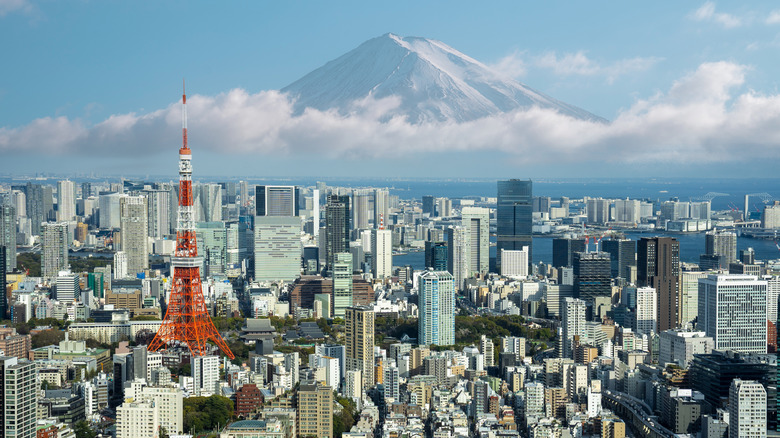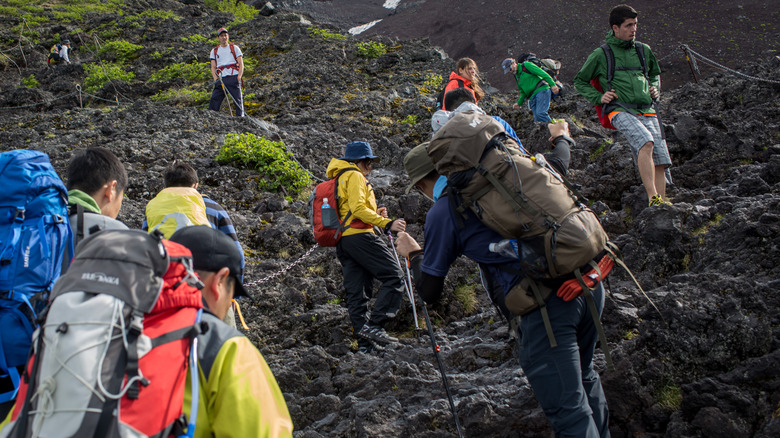The Upsetting Reasons Climbing Mt. Fuji Is Becoming More And More Out Of Reach
Every year, around 200,000 adventurous souls try their luck scaling the one and only Mt. Fuji. Even though climbing Japan's iconic mountain is prohibited for most of the year, people still flock to the peak in droves. It's not hard to see why. Successfully hiking the entirety of Mt. Fuji delivers a sense of accomplishment that you can totally brag about on Instagram, not to mention breathtaking views. But apparently, the Japanese government has had enough of all the foot traffic. In May 2025, it began rolling out stricter measures to thin out the crowd, which include higher entry fees, mandatory safety training, and tighter restrictions on when climbers can ascend.
To the uninitiated, Japan's highest mountain has four climbing routes that can be attempted from July through September: Gotemba, Fujinomiya, Subashiri, and Yoshida, with the latter being the most popular. Previously, only the Yoshida route charged a ¥2,000 fee (about $14), but moving forward, every hiker, regardless of route, will need to cough up ¥4,000 (roughly $28) for the privilege of climbing the legendary mountain. What's more, hikers won't be allowed to simply pay and go. Before you even think about setting foot on the mountain, you must attend a short safety class, which covers everything from hiking safety 101 to local practices. After the session, you'll need to pass a quick test to demonstrate what you've learned. Only after you've passed will you be allowed to begin the climb.
Think that's all? That's where you're wrong. There's a time limit imposed, too. If you want to climb Mt. Fuji, you'll only be allowed to do so during specific hours.
The changes are in response to Mount Fuji's overtourism and to bolster safety
In addition to paying a fee and passing a test, there's another hoop you have to go through if you want to climb Mt. Fuji — making a reservation. Would-be climbers must book their slot through the official Mt. Fuji website, with separate options depending on whether you're a day hiker or planning to sleep in a mountain hut. But don't get too confident — only 4,000 climbers are allowed per day, and given the numbers that Japan's highest peak attracts, spots fill up fast. Don't fret, if you want to simply gaze in awe at the mountain, there are places where you can view it even in the winter.
Then again, it's not just about saving your spot. Part of the reservation process includes agreeing to a list of rules. For starters, you'll need to promise you won't attempt "bullet climbing," the dangerous stunt where people try to summit the peak overnight without resting. You'll also need to swear you'll wear proper gear: rain gear with separate top and bottom layers, proper footwear, and weather-appropriate clothing, which climbers may tend to forget, especially those who are hiking for the first time. Natsuko Sodeyama, a Shizuoka prefecture official, tells the Japan Times, "There is no other mountain in Japan that attracts that many people in the span of just over two months. So some restrictions are necessary to ensure their safety."
Safety aside, the stricter rules are also a direct way to deal with the growing overtourism crisis. Mount Fuji, a UNESCO World Heritage Site, has caught flak for its worsening conditions, with some even dubbing it "trash mountain" (via CNN). And so the new rules and fees might feel like a hassle, but they're the least we can do to keep this iconic peak from collapsing under our boots.

